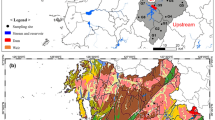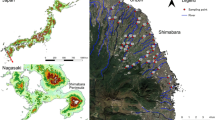Abstract
Data of studies of 2013–2019 were used to assess the current environmental-geochemical conditions of surface water and groundwater in the basin of the Ganjiang River, the largest tributary of Poyang Lake (China). The main objects of studies were the Ganjiang River, its tributaries―the rivers of **jiang and Yuanshui, groundwater of quaternary deposits in the valleys of the Ganjiang River and its tributaries, and the domestic and industrial wastewaters reaching the **jiang River. The analysis of the results included estimating the background concentrations of substances; the comparison of the chemistry of surface water and groundwater with the background characteristics and standards for domestic water quality accepted in Russia and China; the estimation of the saturation indices of river water, groundwater, and wastewater by some minerals and organomineral complexes; correlation and regression analyses aimed at revealing relationships between geochemical characteristics. In addition, the anthropogenic effect on the state of the **jiang River and groundwater in the Ganjiang River basin was evaluated by solving the diffusion equation and the transport equation, respectively. The conditions of water objects were found to be unsatisfactory because of the high concentrations of several toxic trace elements in individual river segments and groundwater; however, in general over many-year aspect, it satisfies drinking water quality standards introduced in China (by the total proportions between the actual and allowable concentrations). The state of the studied groundwater was poorer than that of surface water. This is due to the higher self-purification capacity of surface water in the region because of precipitation of poorly soluble compounds, coprecipitation of some trace elements on particles of river load and bottom sediments, and more intense water exchange.



Similar content being viewed by others
REFERENCES
Alekin, O.A., Osnovy gidrokhimii (Fundamentals of Hydrochemistry), Leningrad: Gidrometeoizdat, 1953.
GN 2.1.5.1315-03. Predel’no dopustimye kontsentratsii (PDK) khimicheskikh veshchestv v vode vodnykh ob’’ektov khozyaistvenno-pit’evogo i kul’turno-bytovogo vodopol’zovaniya (Maximal Allowable Concentrations (MAC) of Chemicals in the Water of Water Bodies Used for Domestic, Drinking, and Recreational Needs), Moscow: Minzdrav Rossii, 2003.
Golovin, A.A., Moskalenko, N.N., Achkasov, A.I., et al., Trebovaniya k proizvodstvu i rezul’tatam mnogotselevogo geokhimicheskogo kartirovaniya masshtaba 1 : 200 000 (Requirements to the Performance and Results of Long-Term Geochemical Map** at a Scale of 1 : 200 000), Moscow: IMGRE, 2002.
GOST (State Standard) 17.1.2.04-77: Characteristics of the State and Taxation Regulations for Water Bodies Used for Fishery, Moscow: Gosstandart, 1977.
Grigoryan, S.V., Solovov, A.P., and Kuzin, M.F., Instruktsiya po geokhimicheskim metodam poiskov rudnykh mestorozhdenii (Instruction on Geochemical Methods for Exploration of Ore Deposits), Moscow: Nedra, 1983.
Guseva, T.V., Gidrokhimicheskie pokazateli sostoyaniya okruzhayushchei sredy: spravoch. materialy (Hydrochemical Characteristics of the Environmental Conditions: Reference Data), Moscow: FORUM, INFRA-M, 2007.
Danilov-Danil’yan, V.I., Venitsianov, E.V., and Belyaev, S.D., Some problems of reducing the pollution of water bodies from diffuse sources, Water Resour., 2020, no. 47, pp. 691–701.
Karaushev, A.V., Metodicheskie osnovy otsenki i reglamentirovaniya antropogennogo vliyaniya na kachestvo poverkhnostnykh vod (Methodological Principles of Assessing and Regulating the Anthropogenic Effect on Surface Water Quality), Leningrad: Gidrometeoizdat, 1987.
Kondrat'eva, I.A., Pechenkin, I.G., and Gavryushov, A.V., Formation conditions of infiltration uranium deposits and hydrochemical methods of their studies, in Mineral’noe syr’e (Mineral Resources), Moscow: VIMS, 2011, issue 24, pp. 1–77.
Krainov, S.R., Ryzhenko, B.N., and Shvets, V.M., Geokhimiya podzemnykh vod. Teoreticheskie, prikladnye i ekologicheskie aspekty (Groundwater Geochemistry. Theoretical, Applied, and Environmental Aspects), Moscow: TsentrLitNefteGaz, 2012.
Rumynin, V.G., Teoriya i metody izucheniya zagryazneniya podzemnykh vod (Theory and Mothods of Studying Groundwater Pollution), St. Petersburg: Nauka, 2020.
Savichev, O.G., Kolokolova, O.V., and Zhukovskaya, E.A., The composition and equilibrium of bottom deposits, Geoekologiya, 2003, no. 2, pp. 108–119.
SanPiN (Sanitary Regulations and Standards) 2.1.5.980-00. Gigienicheskie trebovaniya k okhrane poverkhnostnykh vod (Hygienic Requirements to Surface Water Protection), Moscow: Gosepidnadzor Minzdrava Rossii, 2000.
SP 33-101-2003. Opredelenie osnovnykh raschetnykh gidrologicheskikh kharakteristik (Determination of the Main Numerical Hydrological Characteristics), Moscow: Gosstroi Rossii, 2004.
Fortygina, E., Environmental problems of China, Otechestv. Zap., 2008, no. 3, pp. 167–175.
Benedini, M. and Tsakiris, G., Water Quality Modelling for Rivers and Streams, Springer, 2013.
Chapman, D., Water Quality Assessments: A Guide to the use of Biota, Sediments and Water in Environmental Monitoring, 2nd Ed., Cambridge: Univ. Press, 1996.
China: Jiangxi (Prefectures, Cities, Districts and Counties) – Population Statistics, Charts and Map City Population—Population Statistics in Maps and Charts for Cities, Agglomerations and Administrative Divisions of all Countries of the World, Brinkhoff T., Ed. [Electronic Resource]. https://www.citypopulation.de/en/china/jiangxi/admin. Accessed May 26, 2021.
Feng, L., Hu, C., Chen, X., Li, R., Tian, L., and Murch, B., Modis observations of the bottom topography and its inter-annual variability of Poyang Lake, Remote Sens. Environ., 2011, vol. 115, pp. 2729–2741. https://doi.org/10.1016/j.rse.2011.06.013
GB 5749-2006. Standards for drinking water quality. National standard of the People`s Republic of China. People`s Republic of China., 2007.
Guide to Hydrological Practices, Volume I, Hydrology – From Measurement to Hydrological Information, Geneva: WMO, 2008.
Jiangxi bulletin of soil and water conservation 2019. Official site of the Department of Water Resources of Jiangxi Province, People’s Republic of China. http://slt. jiangxi.gov.cn/art/2020/12/3/art_27420_2953883.html (Accessed May 26, 2021) (in Chinese).
Jiangxi water resources bulletin 2019. Official site of the Department of Water Resources of Jiangxi Province. People’s Republic of China. http://slt.jiangxi. gov.cn/module/download/downfile.jsp?classid= 0&showname=江西省水资源公报2019-定稿. pdf&filename=48d8234b39cd4d11b8ce61b5d1c6f8d0. pdf (Accessed May 26, 2021. (in Chinese)
Shankman, D., Keim, B.D., and Song, J., Flood frequency in China’s Poyang lake region: Trends and teleconnections, Int. J. Climatol., 2006, vol. 26, pp. 1255–1266. https://doi.org/10.1002/joc.1307
Shvartsev, S., Shen, Z., Sun, Z., Wang, G., Soldatova, E., and Guseva, N., Evolution of the groundwater chemical composition in the Poyang Lake catchment, China, Environ. Earth Sci., 2016, vol. 75, p. 1239. https://doi.org/10.1007/s12665-016-6065-8
Shvartsev, S.L., Geochemistry of fresh groundwater in the main landscape zones of the Earth, Geochem. Int., 2008, vol. 46, pp. 1285–1398. https://doi.org/10.1134/S0016702908130016
Soldatova, E., Dong, Y., Li, J., Liu, Y., Zan, J., Boeckx, P., and Sun, Z., Nitrogen transformation and pathways in the shallow groundwater–soil system within agricultural landscapes, Environ. Geochem. Health, 2021, vol. 43, pp. 441–459.
Soldatova, E., Sun, Z., Maier, S., Drebot, V., and Gao, B., Shallow groundwater quality and associated non-cancer health risk in agricultural areas (Poyang Lake basin, China), Environ. Geochem. Health, 2018, vol. 40, pp. 2223–2242.
Soldatova, E.A., Guseva, N.V., Sun, Z., and Mazurova, I.S., Size fractionation of trace elements in the surface water and groundwater of the Ganjiang River and **ushui River basins, China, IOP Conf. Ser. Earth Environ. Sci., 2015, vol. 27, 012037. https://doi.org/10.1088/1755-1315/27/1/012037
Sun, Z., Soldatova, E.A., Guseva, N.V., and Shvartsev, S.L., Impact of human activity on the groundwater chemical composition of the south part of the Poyang Lake Basin, IERI Procedia, 2014, vol. 8, pp. 113–118.
Yan, B., **ng, J., Tan, H., Deng, S., and Tan, Y., Analysis on water environment capacity of the Poyang Lake, Procedia Environ. Sci., 2011, vol. 10, pp. 2754–2759.
Funding
This study was supported by BRICS (BRICS STI Framework Programme): Russian Foundation for Basic Research, project no. 18-55-80 015, and National Natural Science Foundation of China, project no. 51 861 145 308.
Author information
Authors and Affiliations
Corresponding author
Additional information
Translated by G. Krichevets
Rights and permissions
About this article
Cite this article
Soldatova, E.A., Savichev, O.G., Zhou, D. et al. Ecological–Geochemical Conditions of Surface Water and Groundwater and Estimation of the Anthropogenic Effect in the Basin of the Ganjiang River. Water Resour 49, 483–492 (2022). https://doi.org/10.1134/S0097807822030149
Received:
Revised:
Accepted:
Published:
Issue Date:
DOI: https://doi.org/10.1134/S0097807822030149




